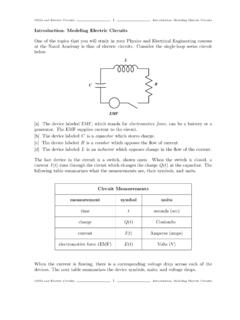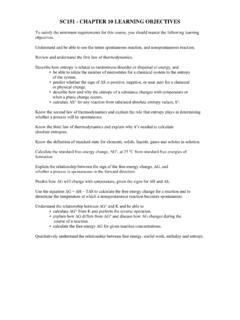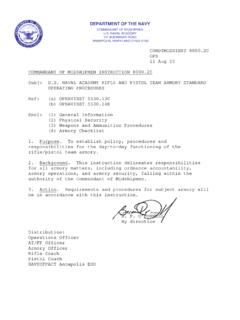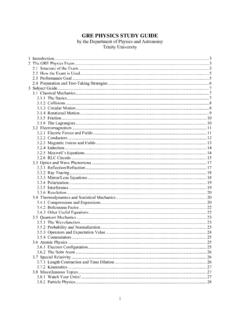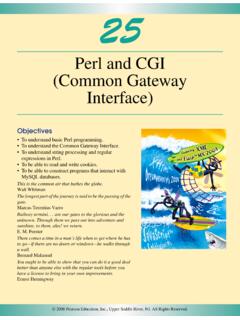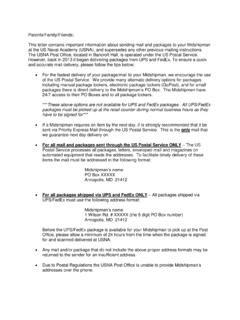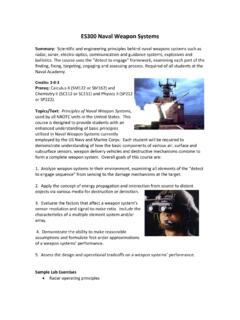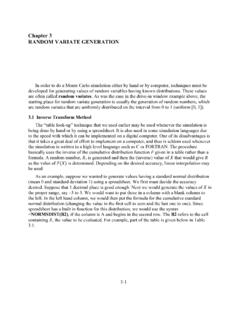Transcription of Lesson 20: Analog to Digital Conversion
1 Lesson 20: Analog to Digital Conversion Objectives: (a) Describe the advantages of Digital over Analog communication. (b) Discuss the basic steps of the Analog -to- Digital Conversion process: sampling, and quantizing/encoding. (c) Given an Analog waveform, sampling rate, and resolution, determine the resulting quantized signal and the binary encoded A/D output. (d) Calculate the Nyquist sampling rate for an Analog signal. (e) Given the number of bits in an A/D process, and sample frequency, determine the generated bit rate. (f) Define quantization error and state the ONLY way to improve it.
2 Connection to Cyber Security In an earlier Lesson you learned about modulation, and that it is impractical to transmit signals at baseband frequencies through free space. Modulation upshifts the frequency of transmission, to allow for smaller antennas. For an AM communication system, the signals at various places in the system is shown below. We could have also used FM or PM, in which case the signal that exists in the communication channel (free space) might look like the following, depending on the information signal (left: frequency modulation, right: phase modulation). In a Digital communication system, the information is composed of 1s and 0s, and the information signal is composed of voltage pulses that represent the 1s and 0s.
3 Hackers can attack our system in a number of ways, such as reading our mail or injecting their own information into our channel. In the Digital age, cyber-attacks usually fall onto Digital communication systems. But where do the 1s and 0s come from? Lesson 23 deals with how 1s and 0s are created from an Analog signal. 1. Analog Systems When you look at the waveform below, you should notice that it is a signal that varies continuously in time and amplitude. If we observed nature, we would see that nature produces signals like this ( , changes in pressure, variations in light, sounds, etc.). Analog systems use Analog electrical signals to represent these natural patterns, such as the voltage signal created from the sound waves of a person speaking into a microphone, shown in the next figure.
4 What do you think might be an example of an Analog system in action? How about an 8-track tape player playing the songs on Michael Jackson s 8-track album, Thriller1. This is a great example of an Analog system, but my guess is you have no idea what an 8-track is. So, let s list some other Analog systems that that may ring a bell: AM/FM radios, rotary telephones, cassette tape players, VCRs, broadcast TVs, the microphone you are singing into at Bancroft s karaoke So maybe you re thinking, I still have no idea what that stuff is! There s probably a reason for that. We don t really use many systems that are completely Analog anymore; Digital communications are more widely used.
5 2. Digital Systems Let s think for a second about comparisons between what was used in the past and what you use now: Type of Information Past Device Present Device Music Cassette Tape CD Videos VHS (VCR) DVD/Blu-ray Disc Broadcast Television Standard Definition TV High Definition TV We want the same types of information but are using a different method to get them: Digital systems. Digital systems use electrical signals that represent discrete (often binary) values. The electrical signals are referred to as Digital signals. Specifically, binary baseband Digital signals use two discrete voltage levels to represent binary 1 or 0 (bits), as shown in the example plots below.
6 Combining multiple bits into words permits us to represent more than just two things. Digital circuits operate on Digital signals, performing logic and arithmetic functions. Interesting fact and important to the class: Digital signals are not representative of signals that occur in nature. Natural signals are Analog , and must be converted into Digital format to be used in a Digital system. Great! So we re using a new method to get the same information. Is this a big deal? It is, because using Digital systems offers a number of advantages over using Analog systems. 3. Digital Advantages Relative noise immunity (What is the number one limiting factor in communications?)
7 Noise.) 1 Michael Jackson s album Thriller (released in 1982) is claimed to be the Best-Selling album of all time! Relative noise immunity is the most important advantage of Digital communications Between the transmitter and receiver, whether the system is Analog or Digital , noise always corrupts the transmitted signal. In general, an Analog receiver has no idea what the received signal is supposed to be after it has been corrupted by noise, but a Digital receiver only has to decide between a finite set of choices: for example, a binary Digital system s receiver must only decide at any time whether or not it is receiving a binary 0 or a binary 1.
8 This means that receiver circuitry can be designed to distinguish between a 0 and 1 even in the presence of a significant amount of noise. It is possible that the noise could be severe enough that the receiver gets confused, and incorrectly decides it is receiving a 0 when it should be deciding a 1 (or vice versa)..these are referred to as bit errors. But in general, Digital systems are much better in noisy environments. In long distance Digital communications, Digital signals can be stripped of any noise in a process called signal regeneration. Consider a long distance transmission that incorporates a set of relay stations in order for the signals to move from transmitter to receiver, such as what is used to connect the east coast of the US to the west Relay stations are needed because the farther a signal travels, the weaker it gets; to make it to its destination, it must be amplified and retransmitted at the relay stations.
9 The relay stations that accomplish signal regeneration are called regenerative repeaters. If this was an Analog system, the Analog signal is received, amplified and retransmitted at each station. However, noise is now a part of the signal, and so is also amplified at each station. In a Digital communication system, a Digital signal is received (receiver decides 0s or 1s), regenerated ( Digital signal recreated based on the 0s and 1s), and then retransmitted at each station. With signal regeneration, the noise can be eliminated at each station. This can only be done in Digital communication systems.
10 Error detection/correction Digital signal processing (DSP) techniques allow the detection and correction of bit errors. Even if a Digital signal contains bit errors, many of these errors can be fixed at the receiver through the use of error correcting codes. Error correcting codes allow, for example, CDs with minor scratches to be played without errors. Analog systems cannot detect or correct errors. Easier multiplexing Multiplexing is the process of allowing multiple signals to share the same transmission channel. For example, Digital telephony allows carrying 24 phone conversations on a single wire (called a T1 line) at the same time.
